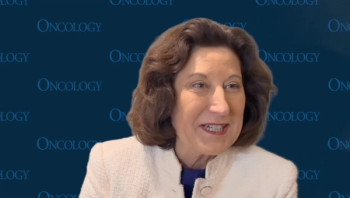
Oncology NEWS International
- Oncology NEWS International Vol 8 No 12
- Volume 8
- Issue 12
Black Women Underrepresented in Breast Cancer Trials
NEW YORK-“African-American women face a substantially higher risk of dying from breast cancer than others in this country and tend to be diagnosed with the disease at a younger age,” Lisa A. Newman, MD, assistant professor of surgery at M.D. Anderson’s Nellie B. Connally Breast Center, said at a Komen Foundation press briefing on clinical trials. The explanation for these variations is unclear at this point, she said.
NEW YORKAfrican-American women face a substantially higher risk of dying from breast cancer than others in this country and tend to be diagnosed with the disease at a younger age, Lisa A. Newman, MD, assistant professor of surgery at M.D. Andersons Nellie B. Connally Breast Center, said at a Komen Foundation press briefing on clinical trials. The explanation for these variations is unclear at this point, she said.
Regrettably also true is the fact that African-American women tend to underutilize two extremely powerful weapons against breast cancer: screening mammography and enrollment in clinical trials.
Pitfalls in Determining Socioeconomic Status
Ethnicity-related breast cancer survival disparities may be linked, in part, to socioeconomic disadvantages, Dr. Lisa Newman said in an interview. Some clinical trials have tried to address the issue by using census tract data to characterize patients socioeconomic status.
Thats potentially misleading because African Americans of more affluent backgrounds may choose to live in less affluent, but predominantly African-American, communities rather than more affluent communities that frequently will be predominantly white, she said.
The best way to determine socioeconomic status is to individualize the data, she said, adding that this approach is more difficult and time-consuming.
Failure of black women to enroll in large numbers in clinical trials of breast cancer may leave unanswered important questions related to the racial disparity in breast cancer survival. For example, in the NSABP clinical trial in which tamoxifen (Nolvadex) was found to reduce breast cancer by nearly 50% in high-risk women, only 1.7% of the participants were black, Dr. Newman said.
Tamoxifen, she noted, appears to be most effective in preventing estrogen-receptor (ER)-positive cancers, and there is substantial evidence that African-American women are more likely to be diagnosed with cancers that are ER negative. On the other hand, she pointed out, taxmoxifen produces few side effects in younger women, and black women are at higher risk for being diagnosed with breast cancer at a younger age.
How do these two lines of data shake out in terms of the applicability of tamoxifen as a chemoprevention agent in African-American women? We really do not have adequate scientific data to answer that question at this point, she said.
Learning From a Tragedy
In part, the reluctance of blacks to enroll in clinical trials is a legacy of the Tuskegee syphilis study, Dr. Newman said. In the 1930s, the US Public Health Service offered free medical care to 399 black men in Macon County, Alabama; all were infected with syphilis. The purpose of the study was to determine the effects of syphilis on the body. The men were not told they had syphilis, and were not offered treatment when penicillin became available in 1947. Follow-up continued until the 1970s, by which time 28 men had died of syphilis.
Dr. Newman called the study an awful experience for African Americans, who were subjected to unethical medical follow-up and care in a government-sponsored study.
Yet even this tragedy offers valuable lessions, she said, on how to improve trial participation in the black community. To recruit the men, the researchers went out to the workplaces, churches, and community-based organizations, she said. The researchers were able to keep track of the men over a span of 40 years in part because they addressed transportation issues. The investigators made sure that the men were able to return to the medical care institutions for appropriate follow-up, Dr. Newman said.
As the chief national medical advisor for the Sisters Network, Inc., an organization of black women who are breast cancer survivors, Dr. Newman is involved in reaching out to the black community on the importance of breast health awareness, including the role of clinical trials.
By giving people transportation access and educating people appropriately, we can improve enrollment in clinical trials, she said, and we can overcome some of the mistrust that does exist between many parts of the community and the medical care institutions.
To get the message out, she would like to see education about breast cancer offered by civic organizations and church groups as well as media outlets targeted to particular ethnic groups.
Articles in this issue
about 26 years ago
SWOG to Study Docetaxel/Estramustine in Advanced Prostate Cancerabout 26 years ago
US Smoking Rates No Longer Falling, Due to More Young Smokersabout 26 years ago
Americans Favor Higher Cigarette Tax to Balance the Budgetabout 26 years ago
Saint Vincents Hospital Opens Comprehensive Cancer Centerabout 26 years ago
New Breast Biopsy Techniques Allow ‘One-Stop’ Proceduresabout 26 years ago
Director of NCI Mentioned as a Candidate to Head NIHabout 26 years ago
Challenges in Designing Chemoprevention Trialsabout 26 years ago
UnitedHealthcare Plan Gives Physicians Final Say on Careabout 26 years ago
New Agents, Sequential Schedules Hold Promiseabout 26 years ago
Half-Day Workshop Can Improve Cancer Team’s Communication SkillsNewsletter
Stay up to date on recent advances in the multidisciplinary approach to cancer.















































































